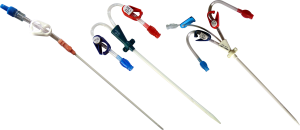A hemodialysis catheter is a medical device that is used to access a patient’s bloodstream for the purpose of hemodialysis treatment. Hemodialysis is a medical treatment that is used to filter waste products and excess fluids from the blood when the kidneys are not functioning properly.
Hemodialysis catheters are typically inserted into a large vein, usually in the neck or chest, and are used to connect the patient’s bloodstream to a hemodialysis machine. The catheter has two openings, one for the removal of blood from the patient and another for the return of filtered blood back into the patient.
There are different types of hemodialysis catheters, but they are typically made from flexible plastic materials such as polyurethane or silicone. They are designed to be safe and comfortable for the patient during the dialysis procedure.
Hemodialysis catheters are generally used as a temporary measure until a more permanent access site, such as an arteriovenous fistula or graft, can be established. This is because hemodialysis catheters carry a risk of infection and other complications.
Despite their temporary nature, hemodialysis catheters play an important role in the treatment of patients with end-stage renal disease. They provide a safe and effective way to access a patient’s bloodstream for hemodialysis treatment when other access options are not available or appropriate.
There are several factors to consider when selecting a hemodialysis catheter, including the patient’s medical history, the expected duration of use, and the patient’s anatomy. The choice of catheter can also affect the risk of complications such as infection and thrombosis.
One common type of hemodialysis catheter is the dual-lumen catheter. This type of catheter has two separate lumens, or channels, that allow blood to be removed from the patient and returned to the patient simultaneously. Dual-lumen catheters are often used for short-term hemodialysis treatment, such as in emergency situations or in patients who require immediate dialysis access.

Another type of hemodialysis catheter is the single-lumen catheter. This type of catheter has only one lumen, or channel, and is typically used for longer-term hemodialysis treatment. Single-lumen catheters are often preferred over dual-lumen catheters for longer-term use because they are associated with a lower risk of infection.
In addition to infection, other potential complications of hemodialysis catheter use include bleeding, clotting, and catheter malposition. These risks can be minimized through proper insertion technique, appropriate catheter selection, and diligent monitoring of the patient during and after dialysis treatment.
Overall, hemodialysis catheters are an important tool in the treatment of patients with end-stage renal disease. They provide a safe and effective way to access a patient’s bloodstream for hemodialysis treatment when other access options are not available or appropriate. However, their temporary nature and potential for complications underscore the importance of timely and appropriate planning for more permanent dialysis access options.


